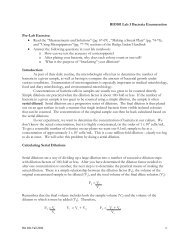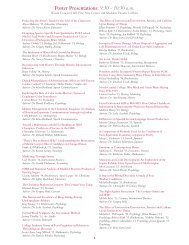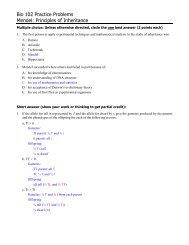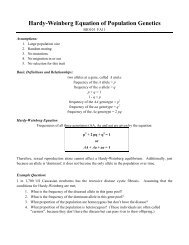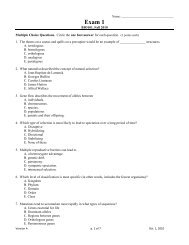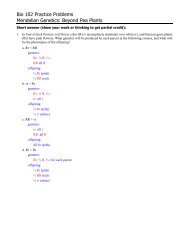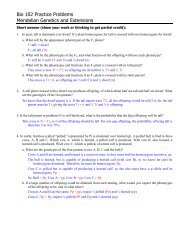More Practice Decoding DNA
More Practice Decoding DNA
More Practice Decoding DNA
You also want an ePaper? Increase the reach of your titles
YUMPU automatically turns print PDFs into web optimized ePapers that Google loves.
BIO 102 Activity: <strong>Decoding</strong> <strong>DNA</strong>!<br />
The following sequence is the non-template strand of the start of the human RPE65 gene (found on human<br />
chromosome 1). To make it easier to read, spaces have been introduced every ten nucleotides; the<br />
nucleotides are numbered below the sequence. Transcription begins at the first nucleotide shown (so, this<br />
would be the +1 nucleotide) and RNA Polymerase II moves to the right, transcribing all of the sequence<br />
shown and continuing through the rest of the gene. The location of Intron #1 is shown.<br />
ACTCTCTGAA CTGGAAGAAA TGTCTATGCA GGATGAGCAT CCTTAAGGTG GTTACAAGAA ACTGTTTGAA ACTGTGGAGG TAT<br />
1 11 21 31 41 51 61 71 81<br />
Encodes Intron #1<br />
1. Is the left end of this <strong>DNA</strong> molecule a 5′ or a 3′ end? How do you know?<br />
This is the 5′ end. If RNA polymerase starts transcribing at the left end and moves rightward, then it<br />
would be reading the template strand from 3′ toward 5′ and making mRNA from 5′ toward 3′. Thus, the<br />
non-template strand is going the same way as the mRNA, from a 5′ end on the left toward a 3′ end on the<br />
right.<br />
2. How did RNA Polymerase II get to this place on chromosome 1 to begin transcribing?<br />
To the left of the sequence shown, there must have been promoter sequences: a TATA box (bound by<br />
TFIID) and other transcription factor binding sites and enhancers (bound by other transcription factors of<br />
various kinds). RNA Polymerase II binds to these transcription factors to recognize where to start.<br />
3. How will the 5′ end of the resulting mRNA be altered?<br />
It will get a 5′ cap—a G nucleotide attached “backward” to the 5′ end .<br />
4. What do we call the region of the mRNA between the 5′ end and the start codon?<br />
The 5′ untranslated region (5′ UTR).<br />
5. There are three different AUG codons in the mRNA. How is the correct start codon selected?<br />
Eukaryotic ribosomes bind the 5′cap and then scan to the first AUG.<br />
6. What are the 15 amino acids at the N-terminus of RPE65?<br />
5 ′ ACUCUCUGAACUGGAAGAA|AUG|UCU|AUG|CAG|GAU|GAA|AGA|AAC|UGU|UUG|AAA|CUG|UGG|AGG|UAU<br />
N - Met Ser Met Gln Asp Glu Arg Asn Cys Leu Lys Leu Trp Arg Tyr<br />
Translation starts at the first AUG. Remember that the intron is spliced out before the mRNA ever gets to<br />
the cytoplasm to be translated!<br />
7. List the anticodons present on the first three tRNAs used to translate RPE65.<br />
3′-UAC-5′ (can also be written 5′-CAU-3′ or just CAU), 3′-AGA-5′, 3′-UAC-5′<br />
8. To help understand this gene and the disease LCA2, we can determine the sequence of many RPE65<br />
alleles from many different people. Allele #1 is the sequence shown above as is known to encode a<br />
functional enzyme. Allele #2 is just like allele #1 except that nucleotide 31 is an A instead of a G. What<br />
are the first 15 amino acids of the RPE65 protein encoded by this allele? What type of mutation is this?<br />
Nucleotide 31 is shown in red in the mRNA sequence in the answer to #6. This will change a CAG codon<br />
to a CAA codon. But, both of these codons encode glutamine (Gln), so there is no change in the aminoacid<br />
sequence of the protein. This is a silent mutation.
9. Allele #3 is just like allele #1 except that nucleotide 60 is a T instead of an A. What are the first 15 amino<br />
acids of the RPE65 protein encoded by this allele? What type of mutation is this?<br />
Nucleotide 60 is shown in green in the mRNA sequence in the answer to #6. This will change an AAC<br />
codon (Asn) to UAC (Tyr): a missense mutation (changes one amino acid in the protein).<br />
10. Allele #4 is just like allele #1 except that nucleotides 29 and 30 (CA) have been deleted. What are the<br />
first 15 amino acids of the RPE65 protein encoded by this allele? What type of mutation is this?<br />
5 ′ ACUCUCUGAACUGGAAGAA|AUG|UCU|AUG|GGA|UGA|AAGAAACUGUUUGAAACUGUGGAGGUAU<br />
N - Met Ser Met Gly Stop<br />
This will cause a frameshift: all the amino acids after this point will be affected, because the codons will<br />
be grouped differently. In fact, this results in the protein halting at a stop codon that before would have<br />
been skipped because it wasn’t in frame.<br />
11. Allele #5 is just like allele #1 except that one extra T nucleotide has been inserted between nucleotides<br />
41 and 42 (CC). What are the first 15 amino acids of the RPE65 protein encoded by this allele?<br />
These nucleotides are within the intron, so they will be spliced out before translation ever begins, and the<br />
protein will be unchanged.<br />
12. Allele #6 is just like allele #1 except that the G at nucleotide 37 is replaced with a C. Due to this change,<br />
the intron is not spliced out after transcription but remains in the mRNA. What are the first 15 amino acids<br />
of the RPE65 protein encoded by this allele?<br />
If the intron (underlined below) is not removed, then the ribosome will simply keep translating into this<br />
sequence (no way of knowing it does not belong!). It would produce the sequence below, fairly quickly<br />
running into a stop codon that would stop translation.<br />
ACUCUCUGAACUGGAAGAA|AUG|UCU|AUG|CAG|GAU|GAG|CAT|CCT|TAA|GGTGGTTACAAGAAACUGUUUGAAACUGUGGAGGUAU<br />
N - Met Ser Met Gln Glu His Pro Stop<br />
13. A woman carries allele #1 and allele #4 on her two homologous chromosome 1s. Her husband has<br />
allele #5 and allele #6 on his two homologous chromosome 1s. What is the probability that their child will<br />
have LCA2 blindness?<br />
Allele #1 encodes a functional enzyme. Let’s call it R 1 (since we know that a functional allele is<br />
dominant over a non-functional allele). Allele #4 is the frameshift allele, so we know that allele won’t<br />
produce any functional protein. We’ll use r 4 for this allele. Mom’s genotype is then R 1 r 4 (heterozygous).<br />
Allele #5 had a mutation in the intron that won’t affect the protein, so this is a functional allele, R 5 . Allele<br />
#6 is the splicing mutation that again encodes a completely non-functional protein and will be recessive,<br />
so we’ll use r 6 . Dad’s genotype is then R 5 r 6 (heterozygous).<br />
There is a ¼ chance their child will get R 1 R 5 ; both of these are functional alleles, so the child would not<br />
be blind. There is a ¼ chance their child will get R 1 r 6 , and this child should also not be blind because of<br />
the dominant R 1 . Likewise, a ¼ chance of R 5 r 4 , also not blind. So, there is a ¾ chance altogether of some<br />
R– combination and a non-blind child. There is a ¼ chance of getting r 4 r 6 , and since both of these alleles<br />
encode non-functional proteins, this child will be blind: thus, a ¼ chance of an LCA2 child.



